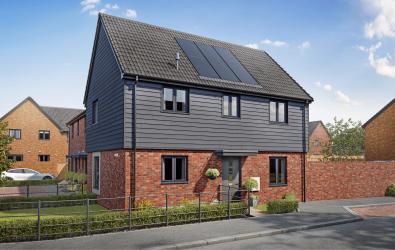As part of our ongoing commitment to providing you with everything you need to know about UK property, we’re introducing the Platform Property Market Update, reviewed quarterly to make sure you’re up-to-date and in the know.
As we move into Q3 2023, we’re starting to see the housing market slowing. Property prices have dropped from the peak levels we saw throughout 2022 and the start of this year but fortunately, the dramatic price drop some experts predicted is yet to happen. Below we explore some of the latest headlines for the UK property market and what we can expect heading into the second half of the year.
1. House price growth starts to correct
At the time of writing, the average UK house price is around £285,800 according to the Land Registry. This is a 1.9% increase from last year but represents a decrease from the record-breaking levels of £292,500 we saw in November 2022.
It’s important to note that prices don’t seem to be falling as quickly as forecasts suggested. The average price in May 2023 was £285,861 - just a £628 decrease from April. It’s also important to note that house price growth reached near unsustainable levels towards the end of the pandemic, which is why a correction is not completely unexpected.
This overall decrease is primarily driven by high mortgage rates and the cost of living crisis, which is directly impacting the number of properties being sold.
Looking forward, there are varying forecasts around how the property market will pan out in the final half of 2023. Knight Frank suggests that prices will drop by 5% both this year and next year. Capital Economics predicts a more significant drop, with forecasts suggesting a fall of 12% by mid-2024.
Despite this, prices remain resilient and according to Kim Kinnaird, director of mortgages at Halifax, ‘the continued affordability squeeze will mean constrained market activity… based on our current economic assumptions, we anticipate that being a gradual rather than a precipitous decline’.
2. Shift in buying attitudes
A secondary impact of higher property prices that we’re currently seeing is buyers looking to purchase smaller properties, lower value homes or even delaying a move until the mortgage market improves. While UK sales volumes are expected to be 23% lower during 2023 as opposed to 2022, research suggests that transactional volume is holding up in affordable areas such as the North East and the Midlands.
The same research shows that sales of larger ‘family homes’ are down 41% over the last month compared to similar periods over the last five years. The sale of smaller homes - typically 1, 2 or some 3-bedroom properties - has declined at a much slower rate.
In general, consensus suggests that the mortgage market - where rates are still above 5% despite a recent cut brought on by declining inflation - is still the main contributor to suppressed activity. For buyers that want a smaller property, however, there are still windows of opportunity in affordable areas.
3. High street banks cut mortgage rates amongst falling inflation
At the time of writing, several major banks including Santander and Barclays have cut mortgage rates following the announcement that inflation has declined.
Santander reduced its mortgage rates by up to 0.29%, while Barclays went further with reductions of 0.3%. This is another notch in a series of rate reductions that have steadily occurred over the last 2 months. While rates are still above 5% for many products, this represents positive news for buyers that are hoping mortgage rates have peaked.
It’s important to remember that the situation is fluid - stronger than expected economic growth means that interest rates may still rise in an effort to combat inflation further.
4. Two regions dominate house price % changes
Recent data suggests that two UK regions are leading the way for the highest annual house price increase - the North East and the East Midlands. Unsurprisingly, these two regions host some of the most affordable housing markets, meaning there’s a higher ceiling for growth and demand.
In both regions, house prices increased between 3.5% and 4% year-on-year, whereas the East of England saw the lowest annual prices increase at 0%.
5. Buy to Let landlords selling up
Data suggests that around 25,000 homes were sold by landlords in the last month, compared to an average of 22,000 each month during Q2.
The number of sales has steadily increased since the pandemic, with landlords still feeling the effects of rising costs, interest rates and obviously, the cost of buy to let mortgages.
This increase in sales also goes against falling property prices. According to Hamptons International, investors that sold a buy to let property in 2023 after a decade of ownership made £94,800 more than they originally paid. This is down 10.1% on similar metrics from 2022.
6. What can we expect going forward?
The main takeaway from the Q3 2023 is that despite the housing market slowing down, it’s still relatively resilient.
While the market continues to see softer price corrections, the trajectory is much more gradual than predicted and a steep drop is unexpected.
As we highlighted in our last UK market update, housing markets that offer affordability and value for money across smaller properties will see a higher number of transactions.
All of these factors mean that Shared Ownership is still a viable alternative for buyers, especially those feeling the pinch of the cost of living crisis. As mortgage rates fall along with inflation, the value of Shared Ownership will become increasingly apparent.







